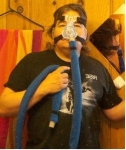jnk wrote:idamtnboy wrote: . . . That's a new book, isn't it? . . .
Yep. Relatively speaking.
idamtnboy wrote: . . . So this author is saying the goal is no upper airway restrictions or disturbances at all. In other words the air passage should be clear and clean and slick as can be so air moves in and out with absolute freedom of movement, i.e., no OAs, no FLs, and a flow graph with uniform amplitude. I wonder, in light of the complexity of the human body and how it interacts with the environment it's in every day and night, how realistically needful or desirable this is. . . .
No one breathes perfectly. The goal is to find the lowest pressure at which one feels one's best, as I understand it.
idamtnboy wrote: Also, relief of upper airway obstruction is associated with resolution of intermittent hypoxemia and hemodynamic swings that accompany obstructive events, with a consequent reduction in long-term cardiovascular morbidity and mortality.
What the heck do those terms mean?
Steady O2 leads to improved blood chemistry and better heart health.
idamtnboy wrote: . . . But, as has been said many times on this forum, too high a pressure can prompt centrals. . . .
An overhyped fear in the context of simple OSA, in my opinion. When you are home-titrating for better numbers, the centrals show up as apneas and are thus accounted for and factored into your pressure choice.
idamtnboy wrote: . . . My sleep doc's assistant said too high a pressure can also cause OAs. How does the author address the conflicting results that may result from the pressure that eliminates "all degrees of upper airway obstruction?" but prompts CAs and possibly OAs?
The words I quoted were an overview of the state of mainstream OSA treatment, as I read them.
The important thing to remember is that the significance of any given "degree of upper airway obstruction" differs from patient to patient. That is why titration is about the effect the breathing seems to have on the sleep of that particular patient, not just how the patient breathes in general in comparison to other patients or some theoretical ideal, from what I've read as a patient.
I guess too high of a pressure during a titration might sometimes cause a central that then allows the airway to close, I don't know, I ain't no tech--but the temporary nature of the unstable breathing that can cause those kinds of centrals in a plain-vanilla OSA patient would mean that those temporary centrals likely would not matter in the long run, once they go away. That's why, in my opinion, home-machine data over time allows for the sweet-spot to be hit: the lowest pressure with the least number of significant events.
But I'm still learning this stuff.
Slowly.
And I have a long way to go.
****************************************************
My thoughts:
jnk, it's interesting to read what all those authors are saying but there are
specific Clinical Guidelines for Manual Titrarions for Patients with OSA by the Task Force of the American Academy of Sleep Medicine (standard practice for PSG). So who cares what those authors are saying?
Example as of 2008:
(1) All potential PAP titration candidates
should receive adequate PAP education, hands-on demonstration,
careful mask fitting, and acclimatization prior to titration.
(2) CPAP (IPAP and/or EPAP for patients on BPAP) should be increased until
the following obstructive respiratory events are eliminated (no specific
order) or the recommended maximum CPAP (IPAP for patients
on BPAP) is reached: apneas, hypopneas, respiratory effort-related
arousals (RERAs), and snoring.
(3) The recommended minimum starting PAP should be 4 cm H2O for pediatric and adult patients, and
the recommended minimum starting IPAP and EPAP should be 8 cm
H2O and 4 cm H2O, respectively, for pediatric and adult patients on
BPAP.
(4) The recommended maximum CPAP should be 15 cm H2O
(or recommended maximum IPAP of 20 cm H2O if on BPAP) for patients
<12 years, and 20 cm H2O (or recommended maximum IPAP of
30 cm H2O if on BPAP) for patients ≥12 years.
(5) The recommendedminimum IPAP-EPAP differential is 4 cm H2O and the recommended
maximum IPAP-EPAP differential is 10 cm H2O
(6) CPAP (IPAP and/orEPAP for patients on BPAP depending on the type of event) should be
increased by at least 1 cm H2O with an interval no shorter than 5 min,
with the goal of eliminating obstructive respiratory events.
(7) CPAP (IPAP and EPAP for patients on BPAP) should be increased from any
CPAP (or IPAP) level if at least 1 obstructive apnea is observed for
patients <12 years, or if at least 2 obstructive apneas are observed for
patients ≥12 years.
(8) CPAP (IPAP for patients on BPAP) should be
increased from any CPAP (or IPAP) level if at least 1 hypopnea is observed
for patients <12 years, or if at least 3 hypopneas are observed
for patients ≥12 years.
(9) CPAP (IPAP for patients on BPAP) should
be increased from any CPAP (or IPAP) level if at least 3 RERAs are
observed for patients <12 years, or if at least 5 RERAs are observed
for patients ≥12 years.
(10) CPAP (IPAP for patients on BPAP) may
be increased from any CPAP (or IPAP) level if at least 1 min of loud or
unambiguous snoring is observed for patients <12 years, or if at least
3 min of loud or unambiguous snoring are observed for patients ≥12
years.
(11) The titration algorithm for split-night CPAP or BPAP titration
studies should be identical to that of full-night CPAP or BPAP titration
studies, respectively.
(12) If the patient is uncomfortable or intolerant
of high pressures on CPAP, the patient may be tried on BPAP. If there
are continued obstructive respiratory events at 15 cm H2O of CPAP
during the titration study, the patient may be switched to BPAP.
(13)
The pressure of CPAP or BPAP selected for patient use following the
titration study should reflect control of the patient’s obstructive respiration
by a low (preferably <5 per hour) respiratory disturbance index
(RDI) at the selected pressure, a minimum sea level SpO2 above 90%
at the pressure, and with a leak within acceptable parameters at the
pressure.
(14) An optimal titration reduces RDI <5 for at least a 15-
min duration and should include supine REM sleep at the selected
pressure that is not continually interrupted by spontaneous arousals
or awakenings.
(15) A good titration reduces RDI ≤10 or by 50% if the
baseline RDI <15 and should include supine REM sleep that is not
continually interrupted by spontaneous arousals or awakenings at the
selected pressure.
(16) An adequate titration does not reduce the RDI
≤10 but reduces the RDI by 75% from baseline (especially in severe
OSA patients), or one in which the titration grading criteria for optimal
or good are met with the exception that supine REM sleep did not occur
at the selected pressure.
(17) An unacceptable titration is one that
does not meet any one of the above grades.
(18) A repeat PAP titration
study should be considered if the initial titration does not achieve a
grade of optimal or good and, if it is a split-night PSG study, it fails to
meet AASM criteria (i.e., titration duration should be >3 hr).
So jnk, the language that you posted above (some from authors) such as:
In other words the air passage should be clear and clean and slick as can be so air moves in and out with absolute freedom of movement, i.e., no OAs, no FLs, and a flow graph with uniform amplitude.
The goal is to find the lowest pressure at which one feels one's best, as I understand it.
That's why, in my opinion, home-machine data over time allows for the sweet-spot to be hit: the lowest pressure with the least number of significant events.
IS IRELEVANT IN LIGHT OF CITY HALL INSTRUCTIONS








